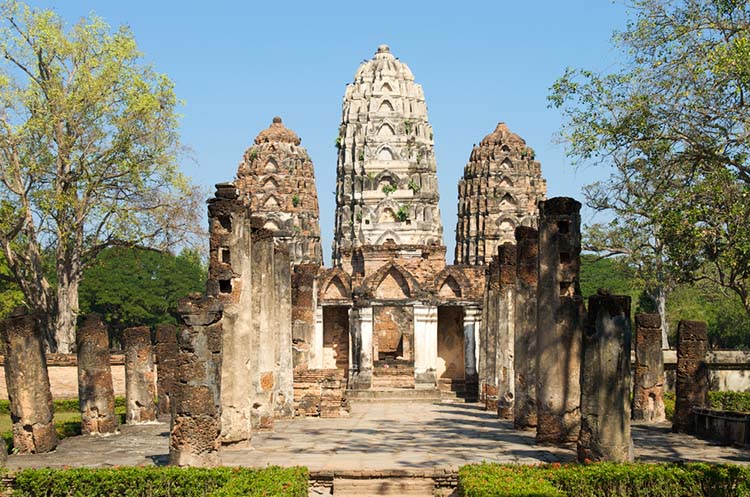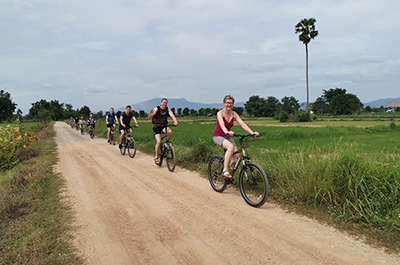
Wat Si Sawai
Located a few hundred meters South West of the Wat Mahathat near the Namo gate inside the old walled city is the Wat Si Sawai temple.
The sanctuary surrounded by a laterite wall is set in attractive park like surroundings with a large pond. The temple which is also known as Wat Sri Savaya consists of three large Khmer style prangs and two viharns.
One of the oldest temples
The Wat Si Sawai is one of the oldest temples in Sukhothai. It is believed to have been founded towards the end of the 12th century or early 13th century before the founding of the Sukhothai Kingdom.
Founded as a Hindu sanctuary dedicated to Shiva
Initially the temple consisted of three prangs, constructed by the Khmer as a Hindu sanctuary dedicated to Shiva. An image of the Hindu God was discovered in the viharn during the early 20th century by Vajiravudh (Rama VI) before he was King. Later on during the Sukhothai period, the Wat Si Sawai was converted into a Buddhist temple and two viharns were added.
3 Khmer style corncob shaped prangs
The Wat Si Sawai’s most striking feature is the three well preserved Khmer corncob shaped prangs. The central tower measures about 15 meters tall, the two towers flanking it are a few meters smaller. The prangs covered with white stucco are set on a low base surrounded by a gallery.
Late 12th century
Towards the end of the 12th century or early 13th century the Khmer started construction of the prangs, but left them unfinished. Centuries later during the Ayutthaya era in the 15th century they were finished in the Lopburi style.
Carvings of mythological creatures
The prangs are adorned with stuccoed carvings of several mythological creatures like multi headed Naga serpents, Makaras (a sea creature) and Kala, a mythological monster like creature without lower jaw often found depicted on Angkor temples. Several Brahman depictions can be found on the towers as well.
Lintel with Vishnu depiction
A lintel carving over the entrance depicts Vishnu reclining on Ananta Shesha, the King of the Naga serpents. Niches in the upper part of the prangs contain images of the Buddha. In all three prangs is a cella containing a pedestal which once held the linga, the representation of the Hindu God Shiva.
Viharns added later
In front of the central prang is the main viharn or assembly hall, of which the walls are in very good condition. Only the base and pillars remain of another viharn in front of it outside the surrounding wall. The viharns were probably added later when the temple was converted into a Theravada Buddhist monument. Outside of the laterite wall to one of the sides is another smaller viharn, of which little remains.
- Wat Mahathat
- Wat Sa Si
- Wat Sorasak
- Wat Tra Phang Ngoen
- Wat Si Chum
- Wat Chetuphon
- Wat Phra Phai Luang
- Wat Saphan Hin
- Private or group tour
- Full day tour from Sukhothai
- Explore historical park & countryside by bike
From Chiang Mai
- Private or group tour
- One day or multiple days tour from Chiang Mai
- Explore historical park & countryside by bike
